Soya Biryani Recipe | Soya Chunks Biryani
This addictive dum-cooked Soya Biryani or Meal Maker Biryani is made with meaty soya chunks, fragrant basmati rice, tender green peas, sweet caramelized onions, aromatic spices and herbs. While this recipe is not a weeknight one-pot wonder, it’s worth every bit of time spent in the kitchen. It tastes super delicious.
About Soya Biryani Recipe
This truly delicious Soya Biryani or Meal Maker Biryani is a properly layered, dum-cooked meal that is packed with flavor.
Cooking in the dum pukht manner gives this biryani a deep permeation of flavors that you just can’t get cooking in any other way.
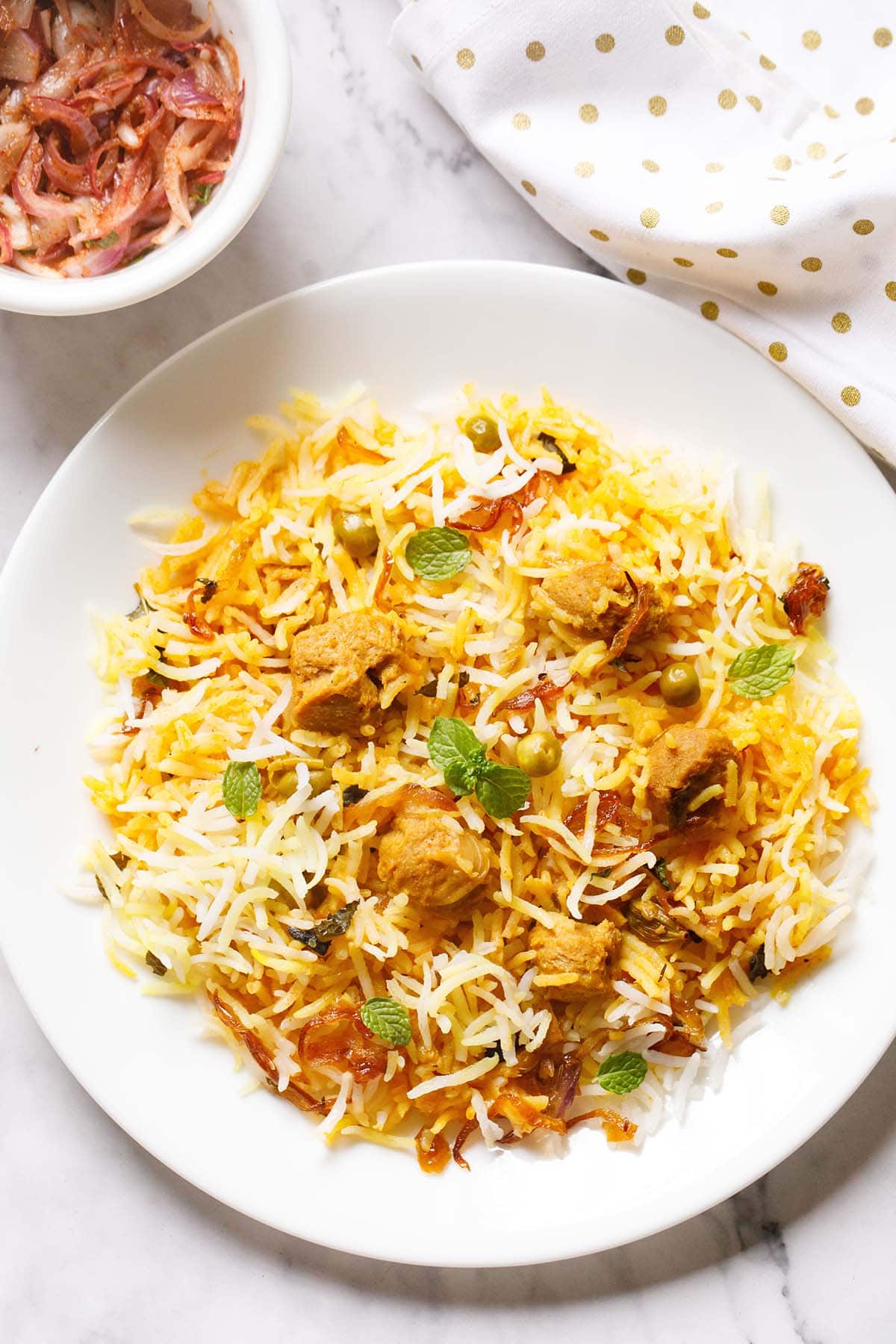
While my recipe for this yummy meal maker biryani is vegetarian, as I have used ghee. But you can easily make it vegan by swapping in oil for the ghee.
I have also made the biryani gravy with coconut milk. If you prefer you can use a vegan curd or coconut cream. For a vegetarian version swap coconut milk with dairy yogurt.
Using Soya Chunks
Soya chunks are called by various names in India like soya nuggets, soya vadi, Meal Maker, textured vegetable protein, nutri-nuggets and also “vegetarian’s meat.” Basically they are a kind of a mock meat made from defatted soya flour.
Of all the requests I receive on a day-to-day basis, one of the most prevalent is for more soya nugget recipes.
Since Biryani is one of my favorite Indian meals (I have nearly 30 on the site!), it seemed like a natural addition to my growing library of Meal Maker recipes. I have already shared a flavorful recipe of Soya Chunks Curry and Meal Maker Fry.
The soya chunks give the biryani a meaty quality while omitting the meat, which is great for a vegetarian like myself. When cooked, the chunks have a soft, almost meaty texture that absorbs any flavors you throw at it.
In fact, if there are any chicken, lamb or other meat-based biryani dishes that you like but want to make vegetarian, give the soya chunks or unripe jackfruit a try. If you are interested you can check this recipe of Jackfruit Biryani.
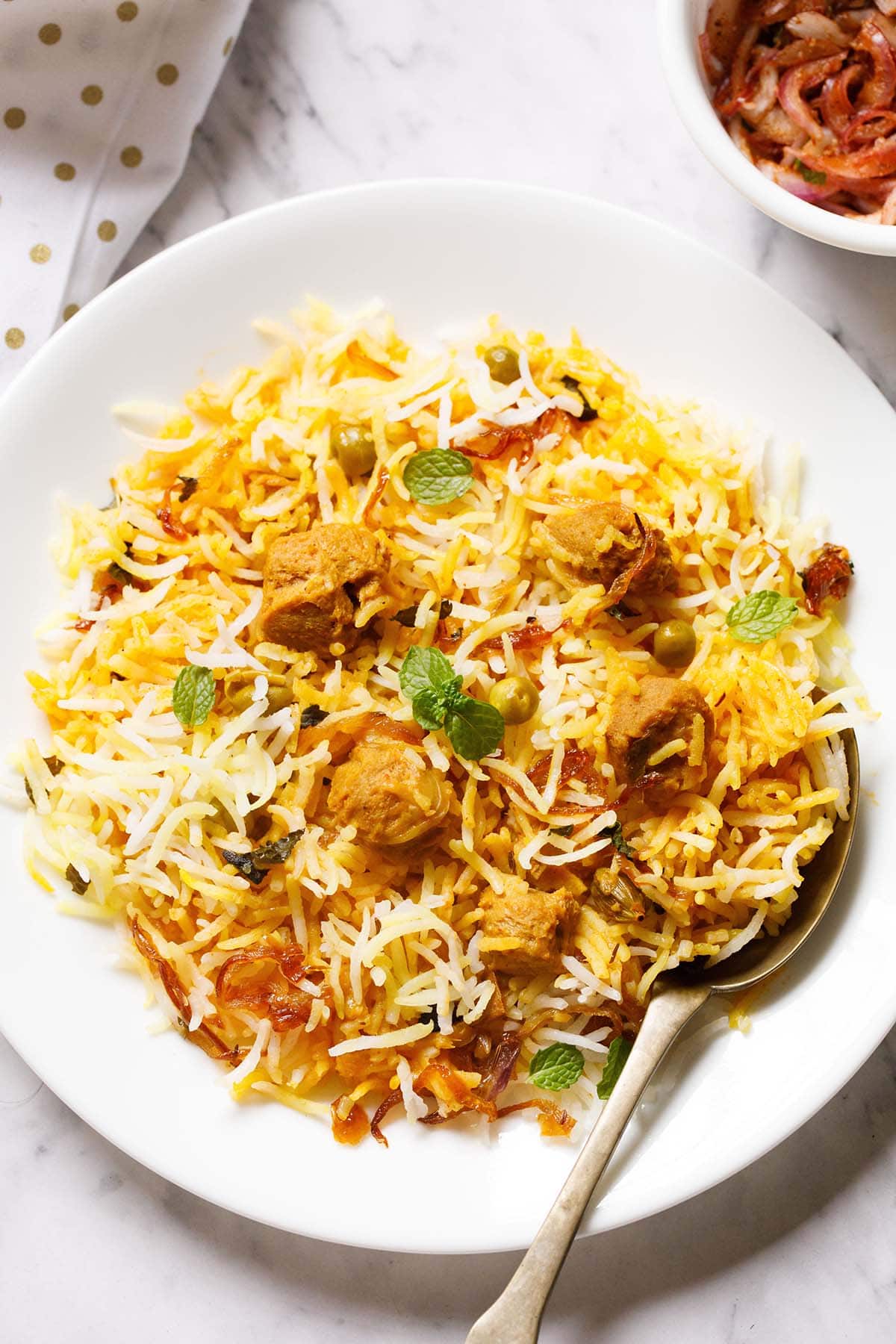
Note: Although soya chunks are rich in protein, I recommend to have them only occasionally because they are highly processed. Keep in mind your digestive capabilities, body constitution and health before you consume them.
Please note that the Meal Maker nuggets require a bit of preparation before use, which I have outlined in the recipe card below.
If you’re looking for a fast and easy one-pot Soya Biryani recipe, check out my Mushroom Biryani and swap in soya chunks for the mushrooms.
How to make Soya Biryani
Before you begin, you’ll want to assemble the various meal maker biryani elements for your mise en place. Once everything is measured out, the steps are quite simple: cooking rice, prepping soya chunks and making the gravy.
Cook Rice
1. Rinse 1.25 cups of basmati rice thoroughly in water until the water is clear of starch. Soak rice in 1½ cups water for 20 to 30 minutes.
Later drain all the water and set the rice aside.
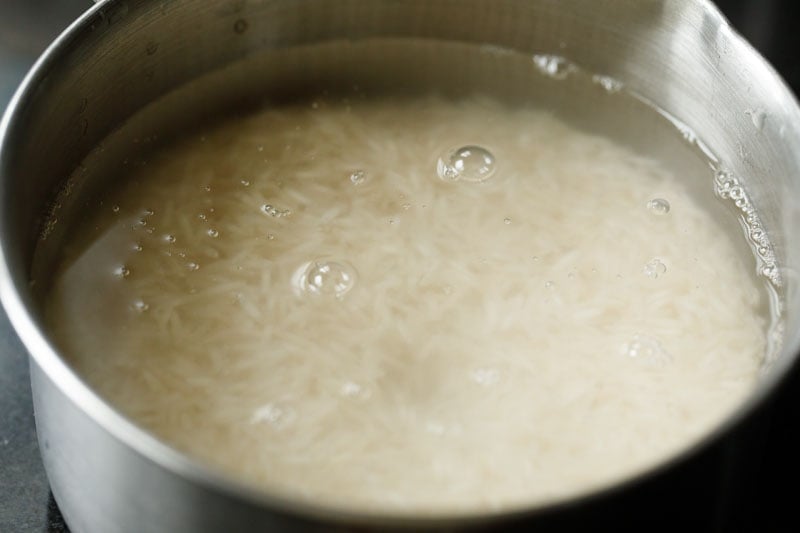
2. In a large pot, add 5 cups water. Add 1 tej patta, 3 cloves, 1 inch cinnamon, 3 green cardamoms, 3 to 4 thin mace strands and 1 teaspoon salt or as required.
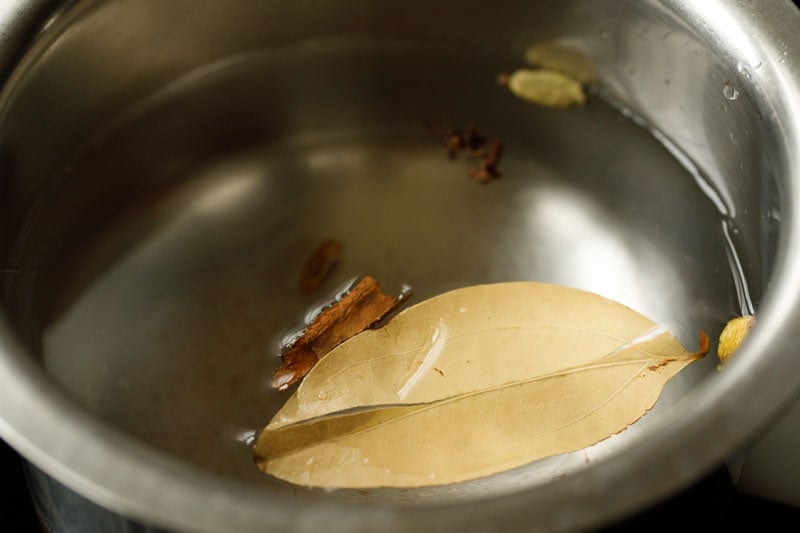
3. Bring spiced water to a rolling boil on high heat.
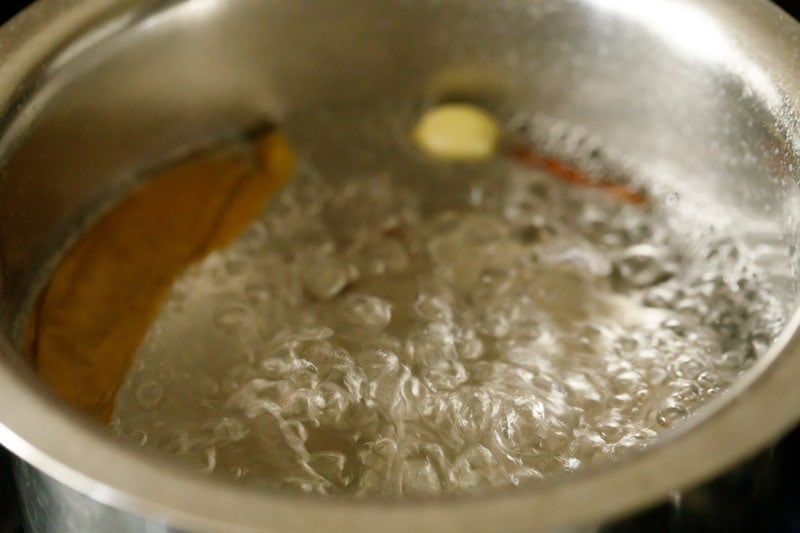
4. Add the rice.
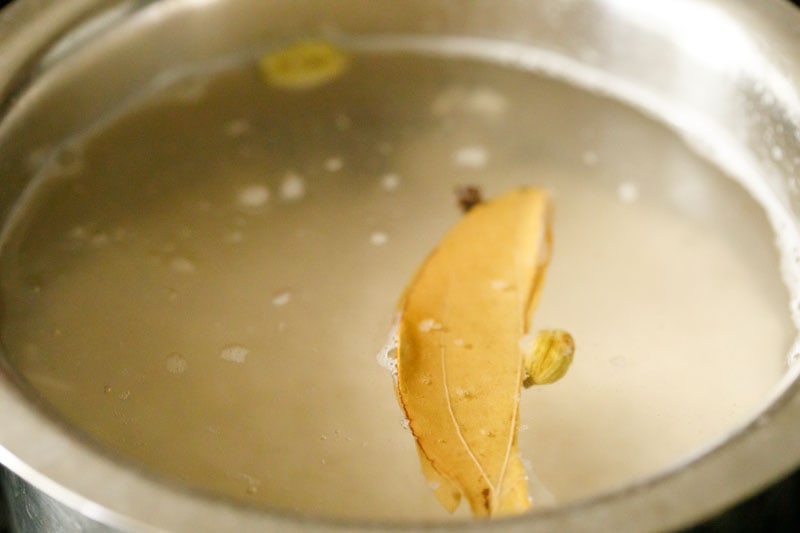
5. Reduce the heat a bit to medium-high. Cook the rice grains until they are 75% done. They should be slightly undercooked, but not al dente. The center should feel a bit raw.
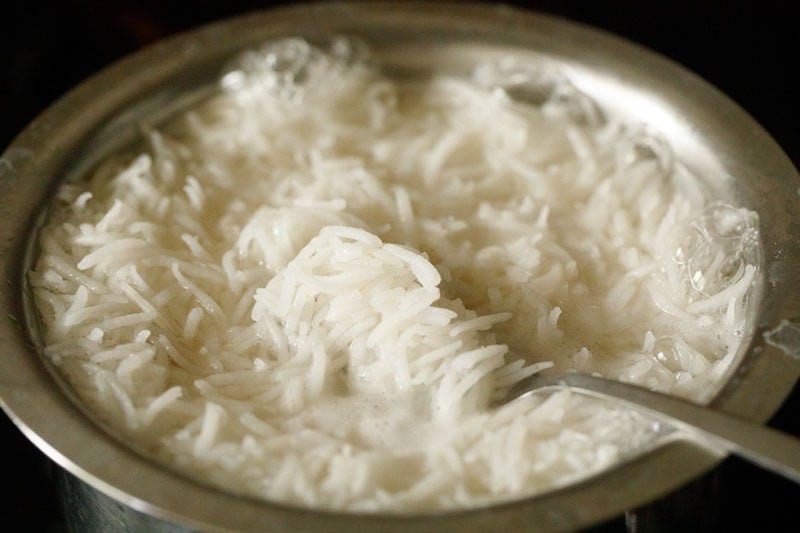
6. Using a strainer, drain all the water. Rinse the rice gently in water. Simply move the strainer all around the water with a gently force of the water. Drain all the water. Cover the strainer and set rice aside.
Note: Do not touch the rice as the grains can break. Rinsing rice ensures that the rice does not cook further.
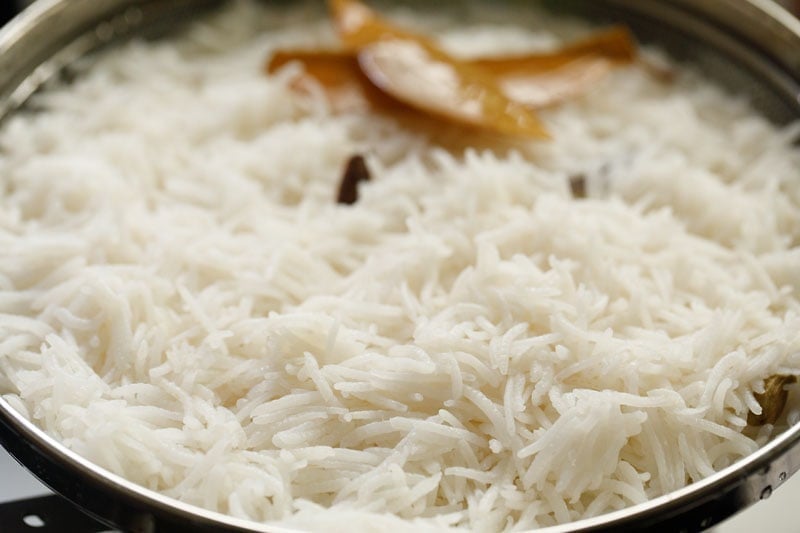
Prep Soya Chunks
7. Rinse 1 cup soya chunks a few times. Next, place the soya chunks, 3 cups water and 1 pinch of salt in a pan.
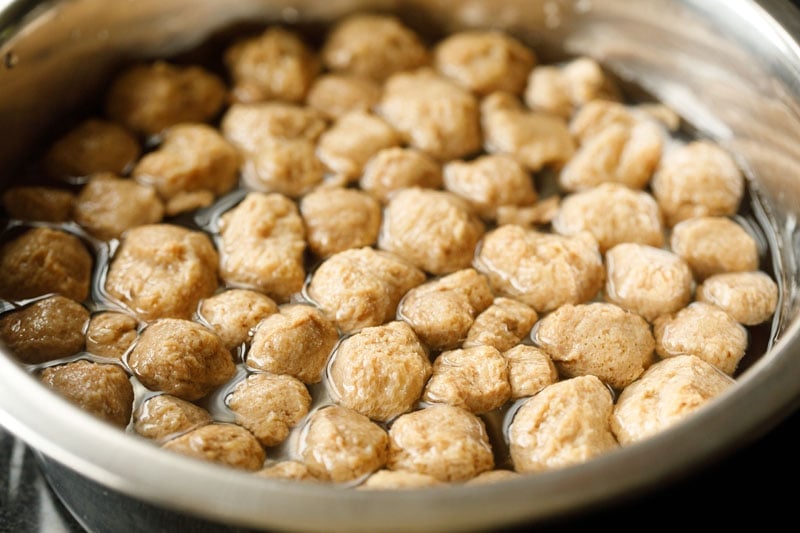
8. Bring to a boil and then further cook for 5 minutes.
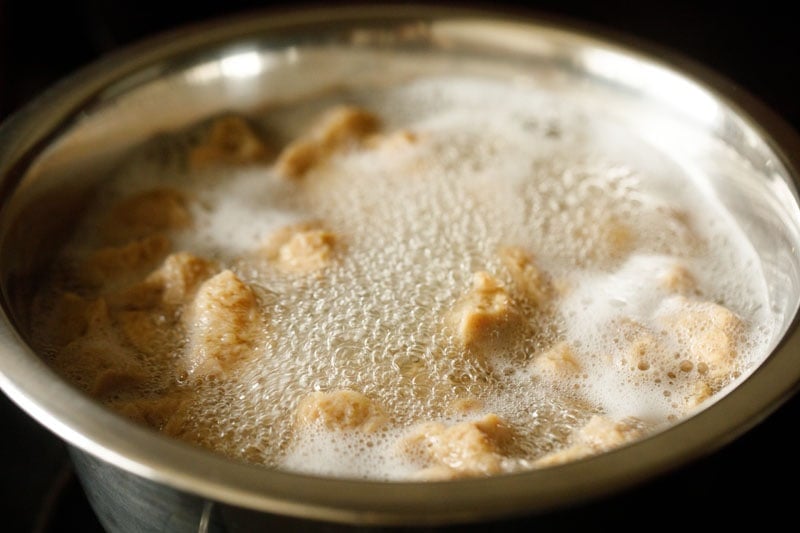
9. In a mesh strainer drain the water. Rinse soya chunks again in fresh water. Again drain the water and squeeze the chunks thoroughly to remove any excess water and moisture. Set aside.
Remember there should be any water logged inside the soya chunks.
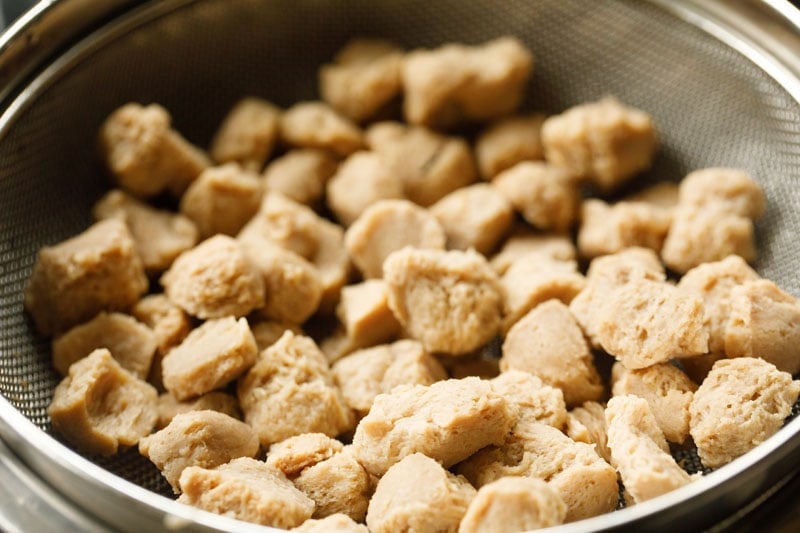
Infuse Saffron Liquid
10. Take warm water (or choice of milk) in a small bowl. Add 25 to 30 saffron strands and set aside to steep for 5 to 10 minutes.
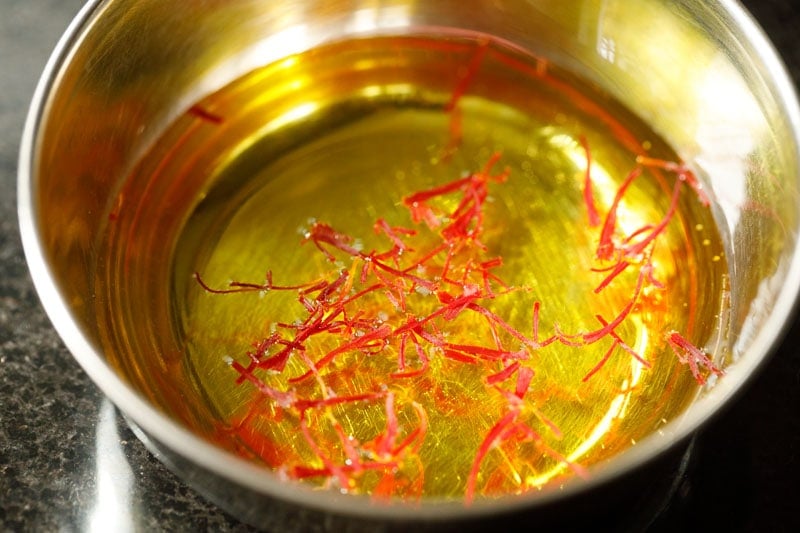
Fry Spices and Onions
11. Heat 3 tablespoons oil or 4 tablespoons ghee in a heavy bottomed pot. Reduce the heat and add the below listed whole spices:
- 1 tej patta
- 1½ inch cinnamon stick
- 3 cloves
- 3 green cardamoms
- 1 small-sized star anise
- 1 black cardamom
- ½ teaspoon caraway seeds (shahi jeera)
Fry for a few seconds so that the spices crackle and release their flavors in the oil. Do not burn them.

12. Add 1½ cups thinly sliced onions. Stirring often, sauté the onions on medium-low to medium heat.
Add a few pinches of salt to quicken the cooking of onions.

13. First the onions will soften and later become light golden.

14. You have to cook them to the point where they become golden and caramelized. Do not brown them too much or burn them or else the biryani will have a bitter taste.

15. When the onions become golden, switch off the heat. Place the pan on the countertop and remove half of the caramelized onions to set aside. If a few spices from the pan pop in with the onions, that is fine.

Make Biryani Gravy
16. Add 1 tablespoon ginger-garlic paste and place the pan back on the stove-top on a low heat.
Sauté ginger-garlic paste for a few seconds until the raw aroma dissipates.
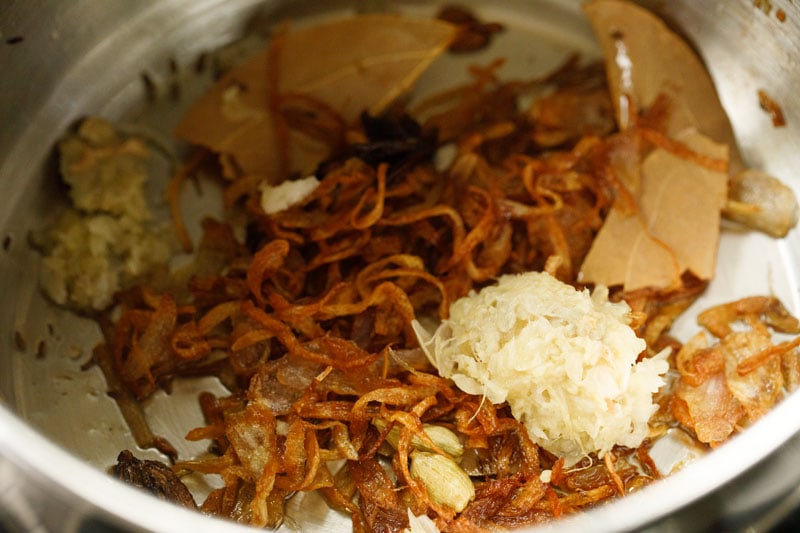
17. At this step we will add the ground spices. If you prefer, switch off the heat here. Add the following ground spices:
- ½ teaspoon turmeric powder
- 1 teaspoon Kashmiri red chilli powder
- 1 teaspoon coriander powder
- ½ teaspoon cumin powder
- ¼ teaspoon garam masala powder
- 2 to 3 pinches of grated nutmeg (about ⅛ teaspoon)
Mix and sauté for a minute on a low heat taking care not to burn the spices.
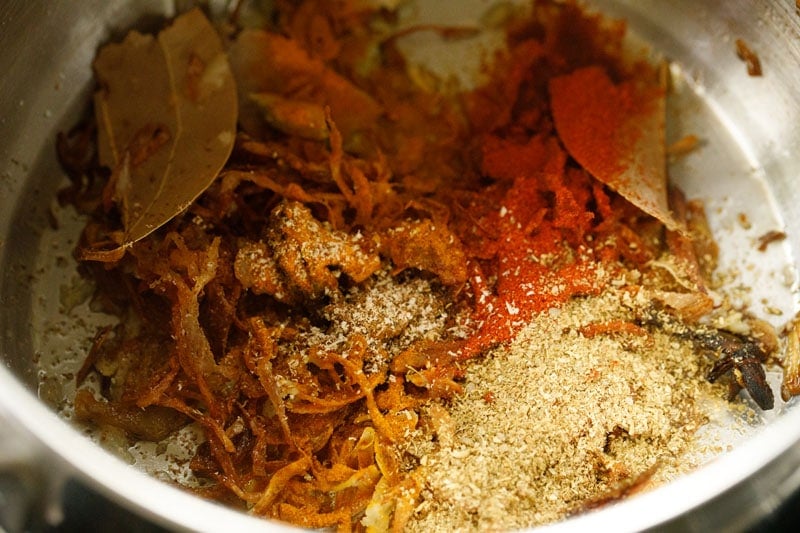
18. Add ¼ cup tomato puree (or ½ cup chopped tomatoes) and 2 tablespoons of chopped mint leaves. Add 2 tablespoons of coriander leaves if using.
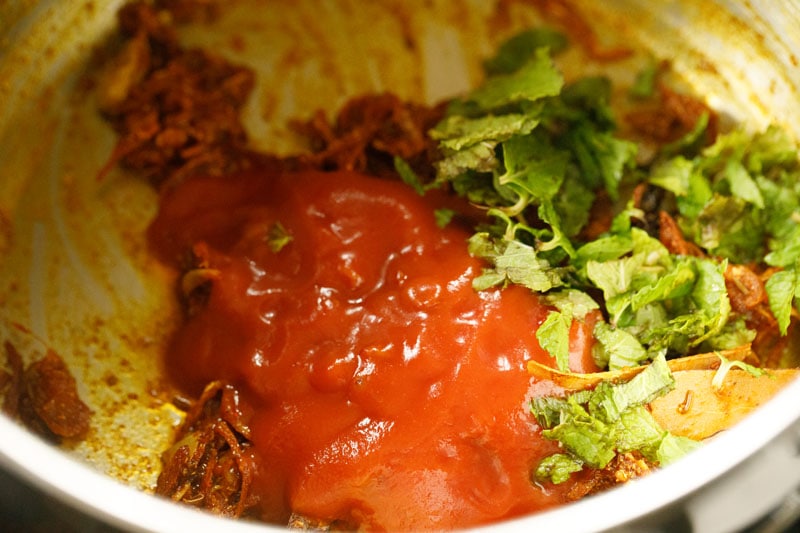
19. Mix and sauté on a low heat until the mixture becomes pulpy and you see the fat releasing from the sides.
If using chopped tomatoes, the tomatoes should soften and become mushy.
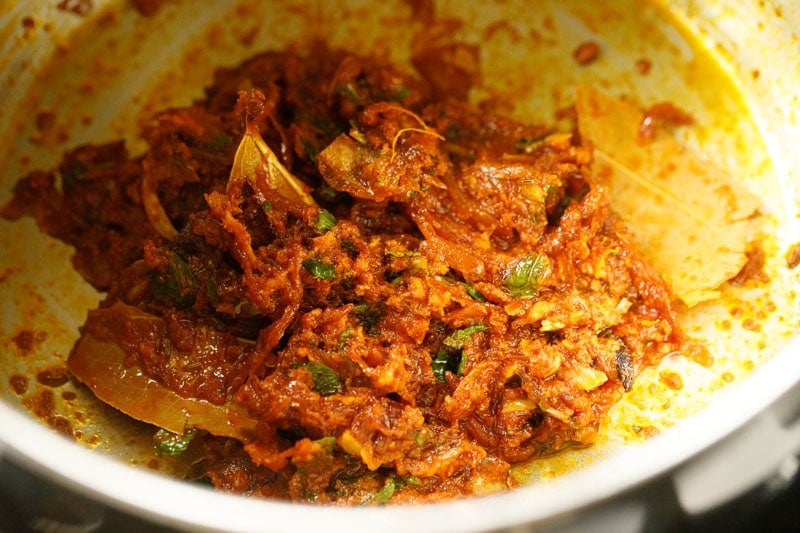
20. Add the prepared soya chunks, frozen green peas (optional) and salt as required.
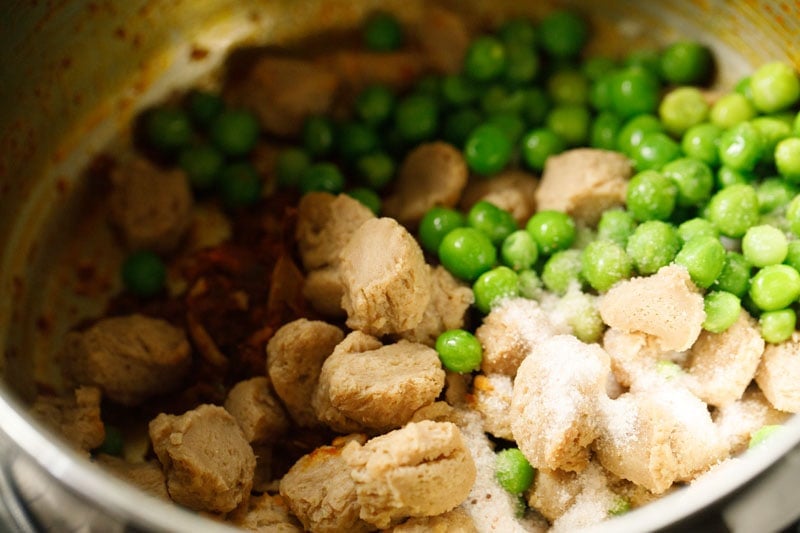
21. Add ¾ cup water and combine well.
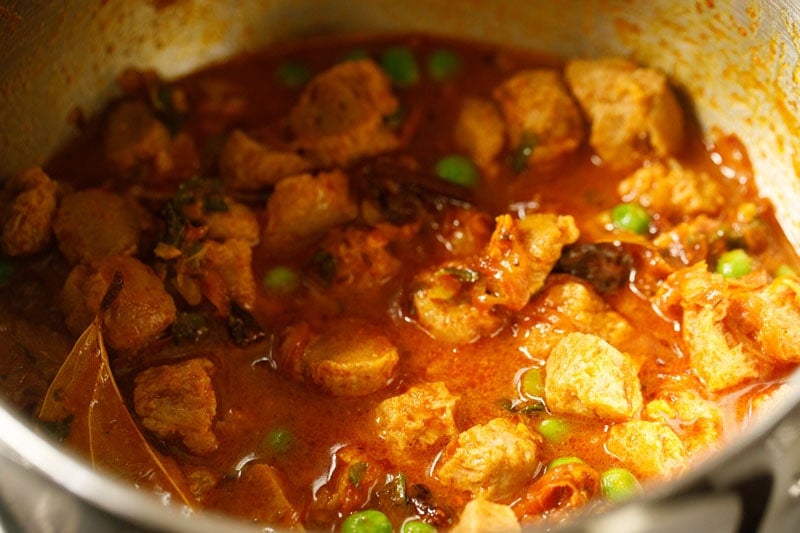
22. Cover the pan and simmer on low to medium-low heat for 10 minutes.
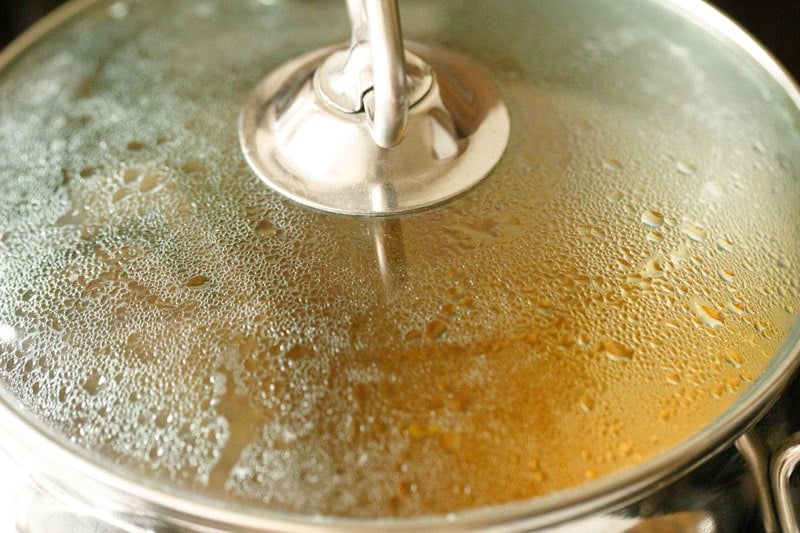
23. Turn off the heat and place pan on the countertop.
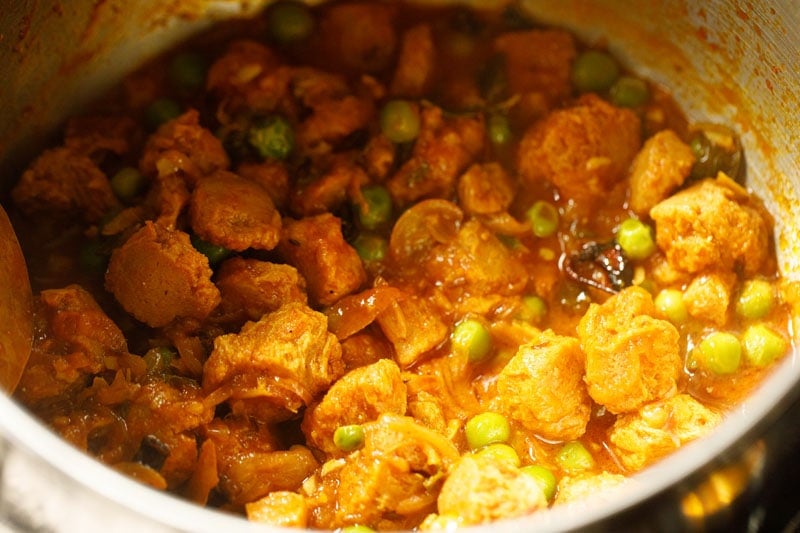
24. Add 1 cup thick coconut milk and 1 tablespoon kewra water (pandanus water) or 1 tablespoon rose water.
If using curd (yogurt) instead of coconut milk, add 1 cup whisked/beaten curd at this point. Mix well.
Note: Use fresh curd and not sour curd.
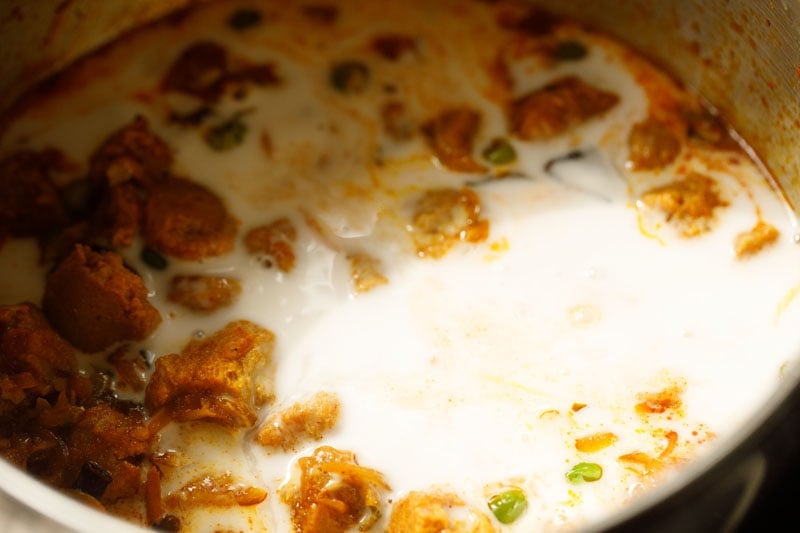
25. Mix and cook on a low heat until the gravy becomes hot. Do not boil, as this would result in the separation of the coconut milk or curd.
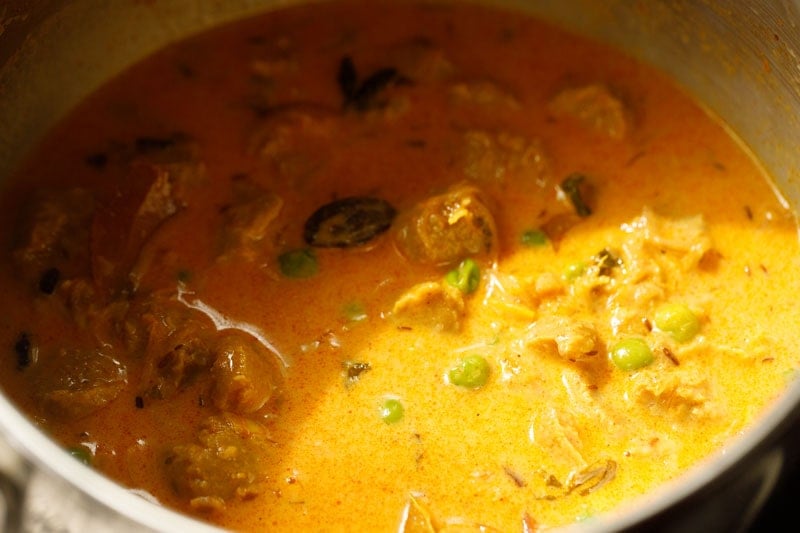
26. Now that the gravy is ready, it is time to layer the biryani for dum cooking. You can make two or four layers. I made 2 layers.
(If you plan to make 4 layers, remove half the gravy from the pan and set it aside.)
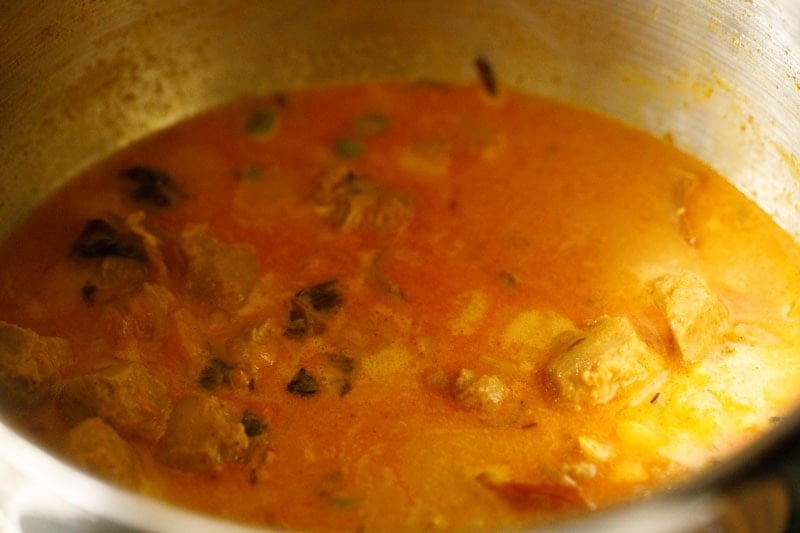
Assemble and Layer
27. Spread rice evenly all over the gravy. (If you are making a 4-layer biryani, use only half the rice.)
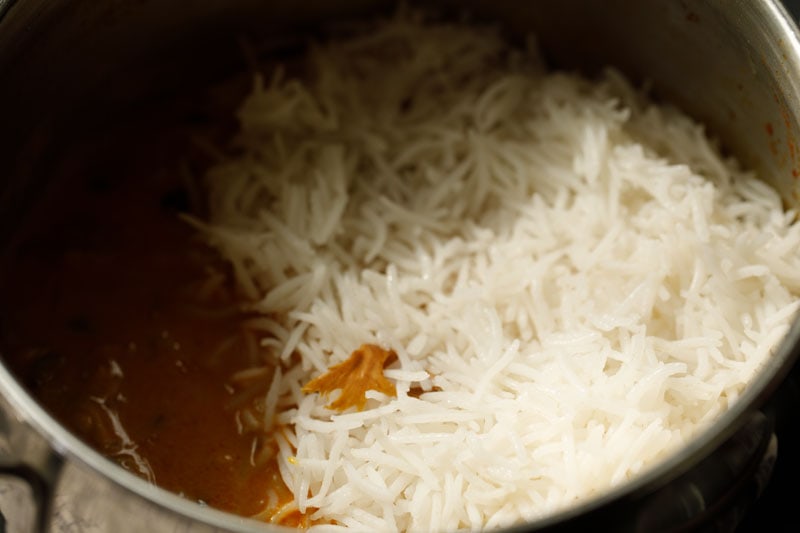
28. Sprinkle the golden caramelized onions and 2 tablespoons chopped mint leaves all over. Pour the saffron infused water (or choice of milk) all over the bed of rice.
(If you are making a 4-layer biryani, use only half the elements listed, then repeat with gravy, rice, onions, mint and saffron liquid.)
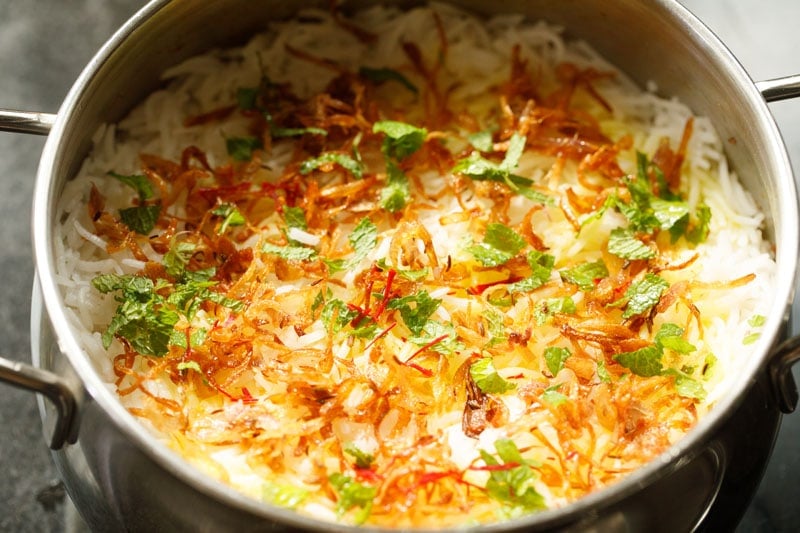
29. Cover the pan with a moistened muslin/cheesecloth or any cotton napkin. You can also seal the pan tightly with a foil.
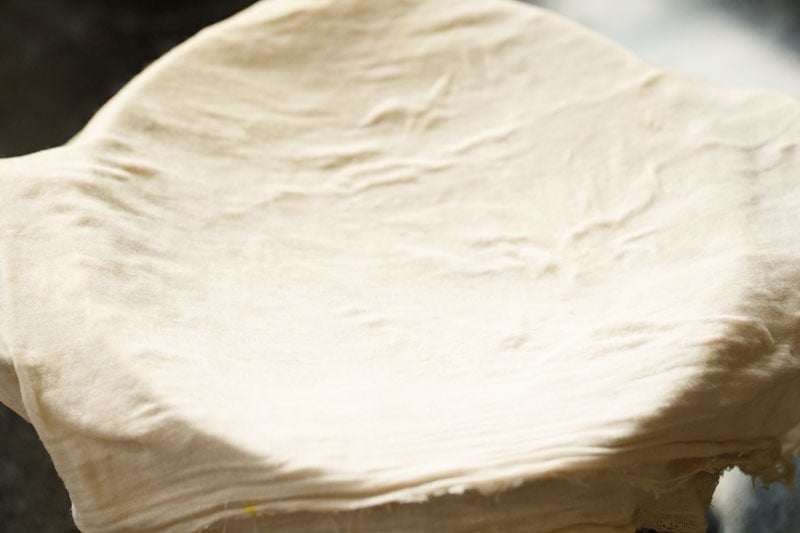
30. Seal tightly with the pan’s lid.
Note: If you do not have a lid for a pan, place a steel lid/plate on the wet cloth. Keep a heavy weight object like a mortar-pestle on the steel lid/plate, so that steam does not escape.
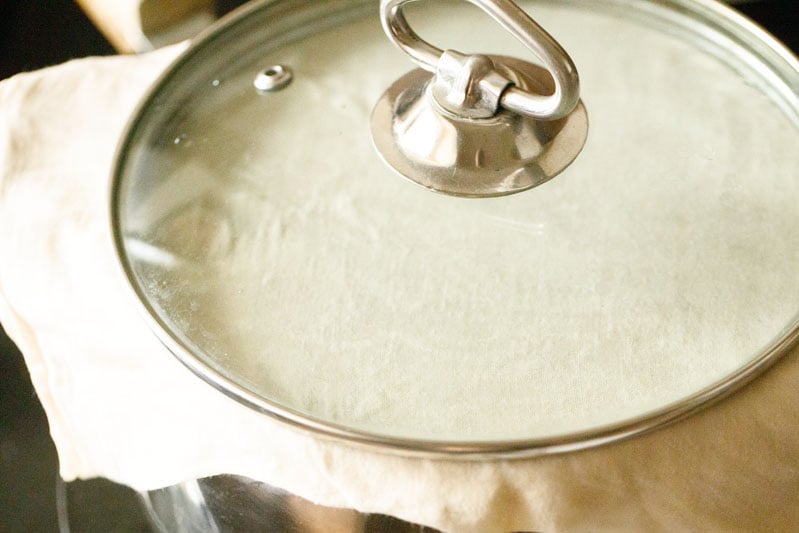
Dum Cook Soya Biryani
31. Place the pot on a skillet/tawa. First cook the biryani for 5 minutes on medium-high heat. Then reduce the heat and cook for 30 to 35 minutes.
When you check the bottom of the pot with a fork or spoon, there should be not gravy or liquids in the pan.
The gravy will be absorbed by the rice as the biryani simmers and slow cooks in the pan. If you see any liquid in the pan, then cook further for 5 to 10 minutes or as needed.
You can also bake in a preheated oven for 35 to 45 minutes at 180 degrees Celsius (or 356 degree Fahrenheit).
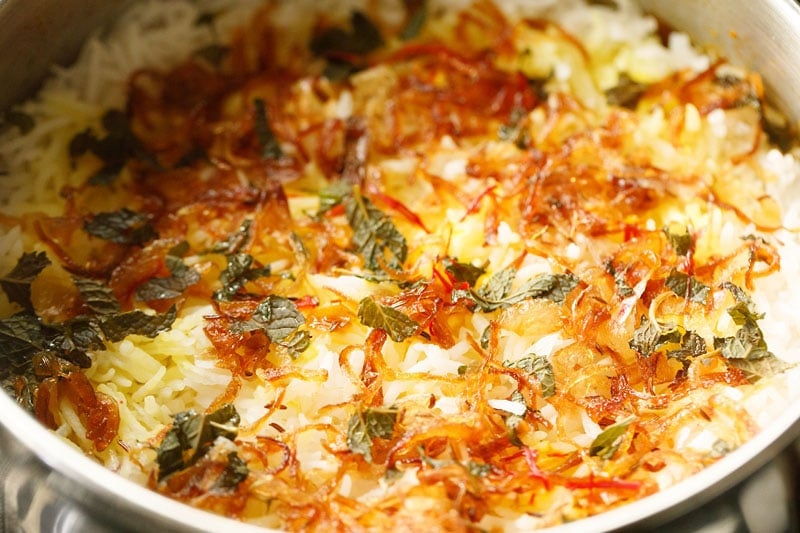
Serving & Storage Suggestions
To serve Soya Biryani, scoop out individual portions into plates or bowls. Garnish with some mint sprigs or coriander leaves, if you prefer.
Onion Salad, pickled onions, Onion Raita, papad or any vegetable salad are great accompaniments. You can also eat it as is. Enjoy!
Leftovers should not be kept for longer than a day in the refrigerator. To reheat, steam for 5 minutes in the Instant Pot or lightly sauté in a frying pan.
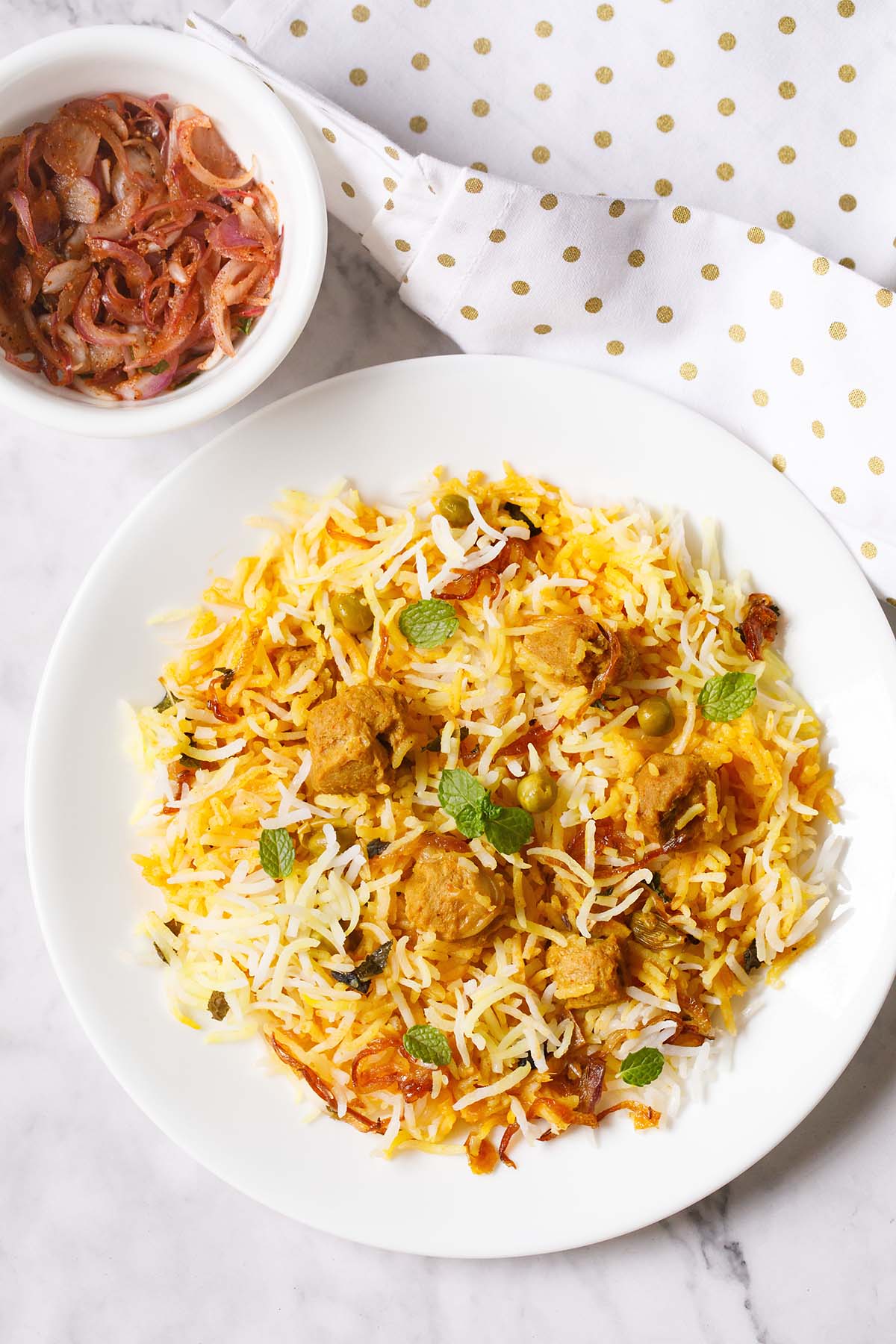
Expert Tips
- Rice: Used aged basmati rice to get a fluffy, separate texture in the Soya Biryani recipe. Rinse the cooked rice gently, and strain all the water well. This will ensure that the rice grains do not cook further.
- Soy chunks: Make sure to drain and squeeze the soya chunks well to remove the excess water from them. There should not be any moisture inside the soya chunks.
- Spicing: For a spicy biryani, increase the quantity of Kashmiri red chili powder or add some green chillies to the gravy.
- Curd: If using curd, then ensure using fresh curd and not a sour one.
- Vegan option: Simply swap ghee (clarified butter) with oil and dairy-based curd (yogurt) with coconut cream or any other plant-based curd. You can also use either milk or a plant-based milk for your saffron liquid.
FAQs
Is soya chunks biryani healthy?
While I always recommend that you speak with a professional for dietary advice, I’d say that for the average healthy person this is a healthy recipe. It is rich in fiber and protein, both of which are important to a balanced diet.
That said, I would recommend using soya chunks only occasionally, as they are a highly processed food.
How long will soya biryani leftovers last?
I recommend keeping any leftovers in the refrigerator for no more than one day. To reheat, steam for 5 minutes in the Instant Pot or sauté in a skillet until warm.
Why is my soya chunks biryani mushy?
Uh-oh. Sounds like you cooked the rice too much in the first step. Rice should only be about ¾ cooked during that first step, as the biryani gravy will finish the job of cooking the rice further during the dum cooking phase.
Also, please be sure to get good quality, preferably aged, basmati rice for the proper consistency. Other varieties of rice may clump, become sticky or mushy.
Can I make a vegan version of this dish?
Absolutely! Simply swap oil for the ghee and use coconut milk like I have done. Or else you can swap with coconut cream or a plant based yogurt. You can also use either water or a plant based milk for your saffron liquid.
Step by Step Photo Guide Above

Soya Biryani Recipe | Soya Chunks Biryani
Ingredients
Prepping soya
- 1 cup (50 grams) soya chunks or meal maker
- 3 cups water
- 1 pinch salt
Cooking rice
- 1.25 cups (250 grams) basmati rice – preferably aged
- 1 tej patta
- 1 inch cinnamon
- 3 cloves
- 3 green cardamoms
- 3 to 4 mace strands – thin and single strands
- 5 cups water
- 1 teaspoon salt or as required
For biryani gravy
- 3 tablespoons oil or 4 tablespoons ghee
- 1½ inches cinnamon
- 3 cloves
- 3 green cardamoms
- 1 black cardamom – optional
- 1 star anise – small-sized, optional
- 1 tej patta
- ½ teaspoon caraway seeds – shahi jeera
- 1½ cups (175 grams or 2 medium to large) onions – thinly sliced
- 1 tablespoon Ginger Garlic Paste or 6 to 7 garlic & 1½ inches ginger, crushed in mortar
- ½ teaspoon turmeric powder
- ½ teaspoon Cumin Powder
- 1 teaspoon Kashmiri Chilli Powder or ½ teaspoon red chilli powder or cayenne
- 1 teaspoon Coriander Powder
- ¼ teaspoon Garam Masala
- 2 to 3 pinches grated nutmeg about ⅛ teaspoon
- ¼ cup Tomato Puree or ½ cup chopped tomatoes
- 2 tablespoons mint – chopped
- 2 tablespoons coriander leaves – chopped, optional
- ½ cup green peas – frozen, optional
- ¾ cup water
- salt as required
- 1 cup Coconut Milk (Thick) or 1 cup curd (yogurt) – preferably thick and well set
- 1 tablespoon kewra water (pandanus water) or rose water
For biryani layers
- 2 tablespoons chopped mint leaves
- 2 tablespoons chopped coriander leaves
- 2 tablespoons water – warm or can use choice of milk
- 25 to 30 saffron strands
Instructions
Cooking Rice
- Rinse basmati rice thoroughly in water until the water is clear of starch. Soak rice in 1½ cups water for 20 to 30 minutes. Later drain all the water and set the rice aside.
- In a large pot, add 5 cups water. Add tej patta, cloves, cinnamon, green cardamoms, mace and salt.
- Bring spiced water to a rolling boil on high heat.
- Add the rice.
- Reduce the heat a bit to medium-high. Cook the rice grains until they are 75% done. They should be slightly undercooked, but not al dente. The center should feel a bit raw.
- Using a strainer, drain all the water. Rinse the rice gently in water. Simply move the strainer all around the water with a gently force of the water. Drain all the water. Cover the strainer and set rice aside. Note: Do not touch the rice as the grains can break. Rinsing rice ensures that the rice does not cook further.
Prepping Soya Chunks
- In a strainer or colander, rinse 1 cup soya chunks a few times with water. Drain the water. Next, place the soya chunks, water and salt in a pan.
- Bring to a boil and cook for 5 minutes.
- Drain the water. Rinse soya chunks in fresh water again. Drain the water again and squeeze the chunks thoroughly to remove any excess moisture. Set aside. Note that there should not be any water logged in the chunks.
Infusing Saffron
- Take warm water (or choice of milk) in a small bowl. Add saffron strand and set aside to steep for 5 to 10 minutes.
Making Biryani Gravy
- Heat oil or ghee in a pot. Reduce the heat and add the whole spices – tej patta, cinnamon, cloves, green cardamoms, star anise, black cardamom and caraway seeds.
- Fry for a few seconds so that the spices crackle and release their flavors in the oil. Do not burn them.
- Add sliced onions. Stirring often, sauté the onions on medium-low to medium heat. Add a few pinches of salt to quicken the process cooking of onions.
- Cook them to the point where they become golden and caramelized. Do not brown them too much or burn them or else the biryani will have a bitter taste.
- When the onions become golden, turn off the heat.
- Place the pan on the countertop and remove half of the caramelized onions to set aside. If a few spices from the pan pop in with the onions, that is fine.
- Add ginger-garlic paste and place the pan back on the stove-top on a low heat. Sauté ginger-garlic paste for a few seconds until the raw aroma goes away.
- At this step we will add the ground spices. If you prefer, switch off the heat here.
- Add turmeric powder, kashmiri red chilli powder, coriander powder, cumin powder, garam masala powder and grated nutmeg.
- Mix and sauté for about 30 seconds to a minute on a low heat taking care not to burn the spices.
- Add tomato puree (or chopped tomatoes) and mint leaves. Add coriander leaves if using.
- Mix and sauté on a low heat until the mixture becomes pulpy and you see the fat releasing from the sides. If using chopped tomatoes, the tomatoes should soften and become mushy.
- Add the prepared soya chunks, frozen green peas (optional) and salt.
- Add water and combine well.
- Cover the pan and simmer on low to medium-low heat for 10 minutes.
- Switch off heat and place pan on the countertop.
- Add coconut milk and kewra water (pandanus water) or rosewater. If using curd, add 1 cup whisked/beaten curd at this point. Mix well. Note: Use fresh curd and not sour curd.
- Mix and cook on a low heat until the gravy becomes hot. Do not boil, as this would result in separation of the coconut milk or curd.
Layering Soya Biryani
- Now that the gravy is ready, it is time to layer the biryani for dum cooking. You can make two or four layers. (If you plan to make 4 layers, remove half the gravy from the pan and set it aside.)
- Spread rice evenly all over the gravy. (If you are making a 4-layer biryani, use only half the rice.)
- Sprinkle the golden caramelized onions and chopped mint leaves all over. Pour the saffron infused water (or choice of milk) all over the bed of rice. (If you are making a 4-layer biryani, use only half the elements listed, then repeat with gravy, rice, onions, mint and saffron liquid.)
- Cover the pan with a moistened muslin/cheesecloth or any cotton napkin. You can also seal the pan tightly with a foil.
- Seal tightly with the pan’s lid.Note: If you do not a lid for a pan, place a steel lid/plate on the wet cloth. Keep a heavy weight object like a mortar-pestle on the steel lid/plate, so that steam does not escape.
Dum Cooking Meal Maker Biryani
- Place the pot on a skillet/tawa. First cook the biryani for 5 minutes on medium-high heat.
- Then reduce the heat and cook for 30 to 35 minutes.
- When you check the bottom of the pot with a fork or spoon, there should be not gravy or liquid left in the pan. If you see any liquids in the pan, then cook further for 5 to 10 minutes. Note: You can also bake in a preheated oven for 35 to 45 minutes at 180 degrees celsius.
Serving & Storage
- To serve soya biryani, scoop out individual portions with all the layers into plates or bowls.
- Garnish with mint leaves or coriander leaves if you prefer. Onion salad, pickled onions, raita, lemon wedges, papad or any vegetable salad are great accompaniments. You can also eat it as is.
- Leftovers should not be kept for longer than a day in the refrigerator. To reheat, steam for 5 minutes in the Instant Pot or lightly sauté in a frying pan.
Notes
- Preferably use aged basmati rice to get the best texture in the biryani – fluffy, long and separate.
- Rinse the cooked rice gently, and strain all the water well. This will ensure that the rice grains do not cook further.
- Remember to cook the soya chunks in water first. Drain the water and squeeze the soya chunks thoroughly to remove the excess water from them. There should not be any water or moisture inside the soya chunks.
- For a spicy tasting biryani, increase the amount of Kashmiri red chili powder or add some green chillies to the gravy.
- If using curd, then make sure to use fresh curd and not a sour one. Simply swap ghee (clarified butter) with oil and dairy-based curd (yogurt) with thick coconut milk, coconut cream or any other plant-based curd.
- You can also use either milk or a plant-based milk for your saffron liquid.


You are my fav..my guru
Thanks a lot Poonam.